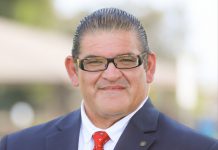
As long-time elected representatives for the northernmost and southernmost reaches of Santa Cruz County, we believe the community conversation over the Rail Trail should be thoughtful, respectful, and inclusive. We have sought to model those ideals both through our respective roles within county and city government and as members of the countywide Regional Transportation Commission.
The debate over how to shape transportation and recreation options along the 32-mile rail corridor has been decades in the making with the shared goals – if not always shared methods – of improving the quality of life for our residents, bolstering the health of our environment, and adding to our economic vitality. Each choice comes with financial costs, some higher and more unpredictable than others, and each choice carries the potential to serve some constituents more meaningfully than others.
The past several weeks has proven to be yet another inflection point. In an effort to advance work on Segments 10 and 11 stretching from Live Oak to Aptos, governing bodies for the County and RTC were recommended by their respective staffs to support an “ultimate trail configuration” that builds a bicycle and pedestrian trail alongside tracks that may someday offer passenger rail service.
The County Board of Supervisors’ decision to fully move forward and accept a historic $68 million state grant was temporarily delayed March 26 on a vote of 3-1 in favor of accepting the project’s Environmental Impact Report while also seeking a clearer understanding of the broader financial implications for unfunded South County segments. At $27 million over budget amid a limited pool of local funds to match future grants and pay for maintenance, a reality check was merited.
Supervisors Bruce McPherson, Manu Koenig and Felipe Hernandez voted in favor of Supervisor McPherson’s motion seeking more financial clarity, while Supervisor Justin Cummings was opposed, having favored, as did Supervisor Hernandez on a failed first vote, to pass the recommendations as presented by County staff.
However, after the RTC voted April 18 to reaffirm its commitment to the ultimate trail configuration – and after Commission staff provided a much more complete financial analysis – the Board of Supervisors voted 4-0 on April 30 to approve Segments 10 and 11 and related agreements, including the California Transportation Commission grant mischaracterized as being in jeopardy.
County and RTC planners predict the funding gap for Segments 10 and 11 could be closed with value analysis on designs, approval of a pending $20 million federal grant, and successful negotiations with Roaring Camp Railroads to bear the cost of moving historic rails that are unsuitable for future rail service. Diligent grant writing is held up as the major strategy for backfilling future gaps.
Still, questions remain unanswered, such as financing for the rail or trail in South County, which has raised equity concerns that beg to be addressed. We will need $400 million to $500 million to build out the South County Segments 13-20. To qualify for state and federal grants, a 10-20 percent local match will be required, which could mean another $40 million to $100 million. What’s more, the RTC reports that maintenance of the Rail Trail corridor will cost $66 million between now and the end of Measure D in 2047.
Passed by voters in November 2016, Measure D provides local funding for roads, Highway 1 improvements, METRO, ParaCruz, and rail. Measure D’s Active Transportation Program (ATP) will have $97 million remaining after meeting $77 million in commitments related to the Mid and North County ultimate trail segments. Reserving most of the rest of those ATP funds for South County projects and overall corridor maintenance would be prudent, as was urged April 18 by RTC Commissioner Eduardo Montesino and will be considered during the June 6 RTC meeting.
Controlling costs and ensuring adequate resources to maintain the entire corridor are necessary to being responsible stewards of public dollars and demonstrating that we take social equity seriously. Continuously evaluating the financial feasibility of enormous infrastructure projects is not obstructionism – it’s a hallmark of good governance.
Bruce McPherson is the Fifth District Supervisor for Santa Cruz County. Eduardo Montesino is the First District Councilmember for the City of Watsonville. Both serve on the Santa Cruz County Regional Transportation Commission.












…complete ambivalence regarding the most important, most pressing, and potentially the most damaging issue involved with the Rail/Trail…not a single paragraph, sentence, word or thought expressed any concern with the human impact issue! The Rail/Trail Commission has informed residents of encroachment claims. Union Pacific fenced the rail corridor over half a century ago…which has served as a property boundary for homeowners and businesses in the mid-county area and beyond. Now they tell us we need to move! Don’t worry about the costs taxpayers will be required to cover! They are the golden goose…don’t forget about adding to the homeless population…don’t worry about the legacy of this boondoggle laid at your feet!…WAIT!…What?